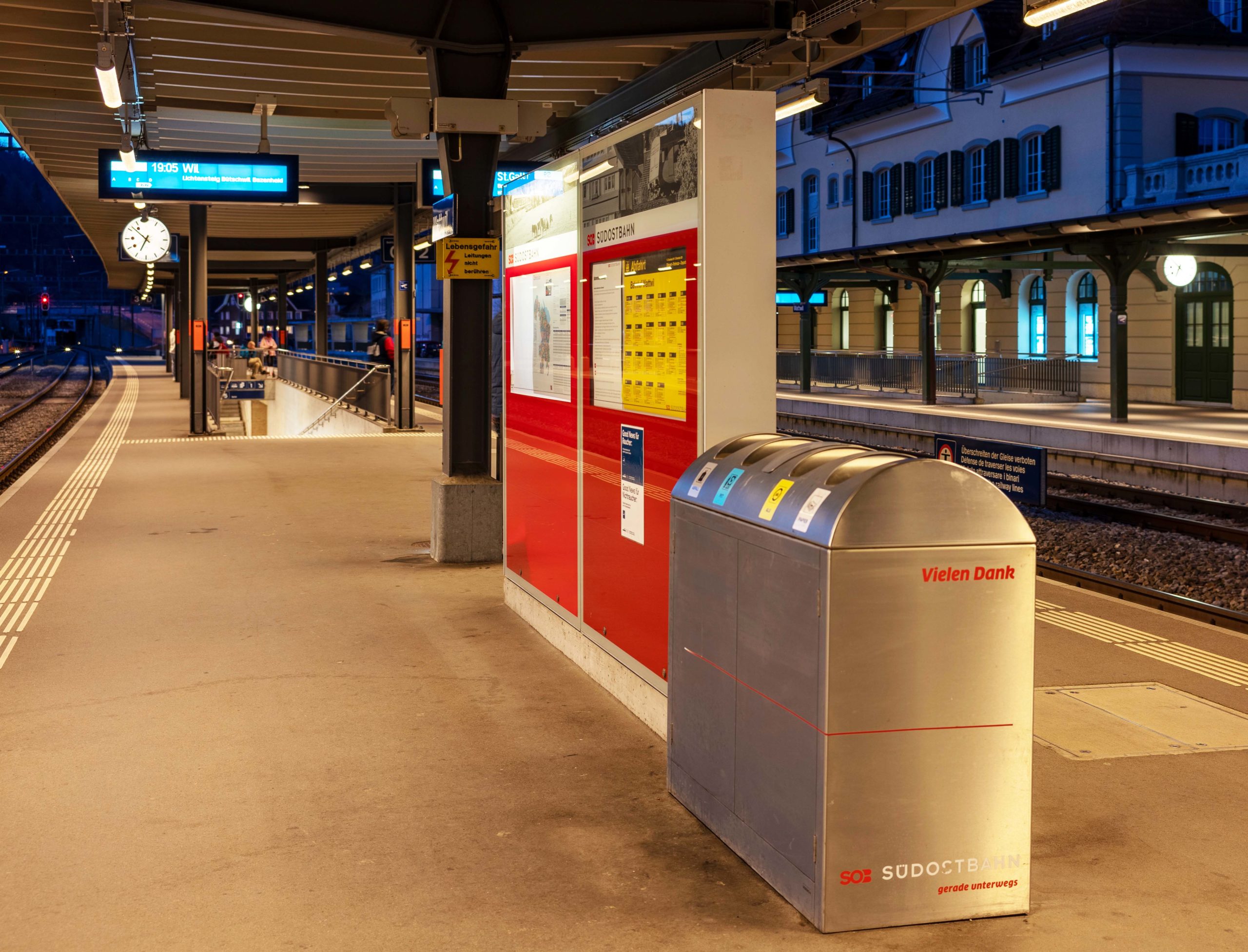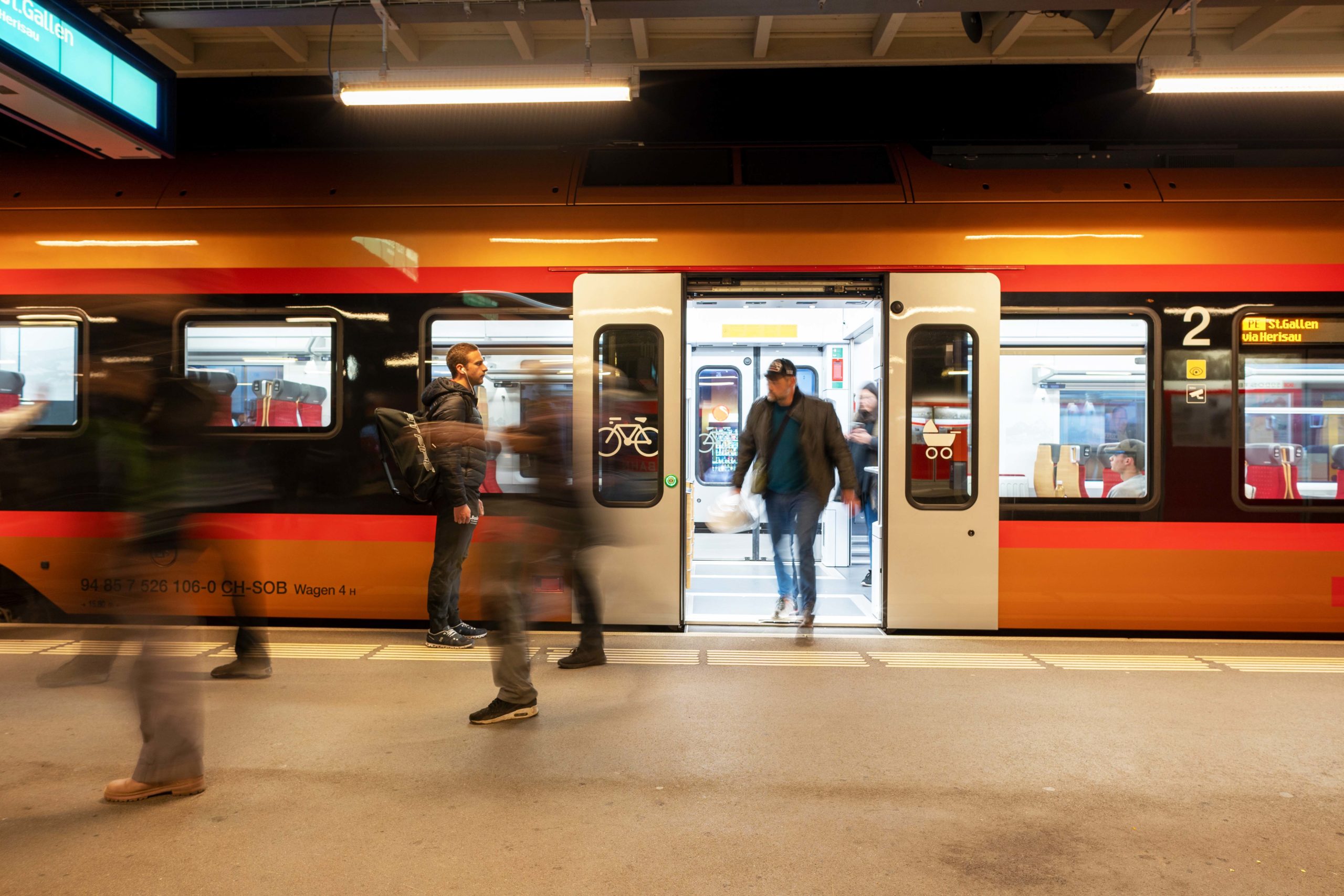Funkwerk Mobility Platform: our References
Südostbahn (SOB) – Switzerland
Proven in practice: On this page you will find use cases and references relating to the use of the Funkwerk Mobilty Platform.
The Swiss Southeast Railway is a railway company in central and eastern Switzerland based in St. Gallen. It was created in 2001 by a merger of the former local railway company and the Bodensee-Toggenburg-Railway and now operates a route network with a length of 123 kilometers. Characteristic for this are gradients of up to 50 per thousand.
With the completion of the modernisation of the route network at Southeast Railway, the timely provision and dissemination of passenger information with the installed customer information system (CIS) from Funkwerk is automated. The complete system adapted to the operator’s needs was gradually installed by 2011 and since then has been continuously developed accordingly.
Automated passenger information for all stations of the route network
The SOB conveniently creates both its target timetable and longer-term scheduling timetables with the timetable editor of Funkwerk Systems GmbH. Passenger information for the stations of the route network is automatically calculated and derived from the timetable data.
The integrated control and information system, called ILTIS for short, provides real-time information on train movements to the customer information system. In addition, train station sensors provide up-to-date data on the entry, stop, arrival and departure of trains at the station tracks. In principle, the CIS processes these data automatically and supports the information manager in addition to normal operation also in exceptional situations such as changes in business transactions and in the case of highly disturbed operation.
Calculation between actual and planned timetables calculates train time forecasts, taking into account catch-up times in the event of delays. All this data is used to display up-to-date passenger information and is generated automatically and up-to-date accordingly.

Monitoring out of the operations centre /
interfaces to SBB system
The high degree of automation of the HIS reduces manual work. The system enables a relief of the operator and at the same time a high information service for the passengers. From the operations center in Herisau, the information managers monitor the processes about passenger information. Here, daily timetables can be controlled and managed, station-bound devices can be controlled, current train routes including connection/ replacement properties are monitored and additional business transactions are triggered. This provides a good overview of the entire route network in topological and graphical form.
Prepared information is provided to the passenger at platforms by means of indicators and announcements. In addition, interfaces to the SBB’s Customer System CUS ensure cross-traffic passenger information. From there, for example, the timetables of the Appenzeller Bahn and of the postbuses are taken over and taken into account for the modal connection calculation.
Visual passenger information with TFT and LCD
23” and 40” TFT screens serve as departure and pre-indicators. Pre-reading infosteles provide important information, especially for the visually impaired traveller. LCD destination displays also show the current coach positions. In addition, they can be automatically switched off timed or manually during periods of low traffic in order to reduce operating costs. The reconnection is event-controlled, for example by an entrance of a train, automatically time-controlled or manually. The volume of the announcements is also reduced in favour of the residents in a time-controlled manner (nightly reduction). In general, announcements are automatically synthesized and issued using text-to-speech technology. This technology offers a consistently high quality at lower costs.
Components of the
Mobility Platform
Passenger information
Passenger information systems enable the fully automatic control of all processes in the operational sequence.
Displays
Indicators, displays, columns and monitors provide passengers with visual information in real time.
Text-to-Speech
Text-to-speech is the digital generation of speech from text. Announcements can be synthesised live.
Funkwerk Mobility Platform: our references
Südostbahn (SOB) – Switzerland
Proven in practice: On this page you will find use cases and references relating to the use of the Funkwerk Mobilty Platform.
The Swiss Southeast Railway is a railway company in central and eastern Switzerland based in St. Gallen. It was created in 2001 by a merger of the former local railway company and the Bodensee-Toggenburg-Railway and now operates a route network with a length of 123 kilometers. Characteristic for this are gradients of up to 50 per thousand.
With the completion of the modernisation of the route network at Southeast Railway, the timely provision and dissemination of passenger information with the installed customer information system (CIS) from Funkwerk is automated. The complete system adapted to the operator’s needs was gradually installed by 2011 and since then has been continuously developed accordingly.
Automated passenger information for all stations of the route network
The SOB conveniently creates both its target timetable and longer-term scheduling timetables with the timetable editor of Funkwerk Systems GmbH. Passenger information for the stations of the route network is automatically calculated and derived from the timetable data.
The integrated control and information system, called ILTIS for short, provides real-time information on train movements to the customer information system. In addition, train station sensors provide up-to-date data on the entry, stop, arrival and departure of trains at the station tracks. In principle, the CIS processes these data automatically and supports the information manager in addition to normal operation also in exceptional situations such as changes in business transactions and in the case of highly disturbed operation.
Calculation between actual and planned timetables calculates train time forecasts, taking into account catch-up times in the event of delays. All this data is used to display up-to-date passenger information and is generated automatically and up-to-date accordingly.

Monitoring out of the operations centre /
interfaces to SBB system
The high degree of automation of the HIS reduces manual work. The system enables a relief of the operator and at the same time a high information service for the passengers. From the operations center in Herisau, the information managers monitor the processes about passenger information. Here, daily timetables can be controlled and managed, station-bound devices can be controlled, current train routes including connection/ replacement properties are monitored and additional business transactions are triggered. This provides a good overview of the entire route network in topological and graphical form.
Prepared information is provided to the passenger at platforms by means of indicators and announcements. In addition, interfaces to the SBB’s Customer System CUS ensure cross-traffic passenger information. From there, for example, the timetables of the Appenzeller Bahn and of the postbuses are taken over and taken into account for the modal connection calculation.
Visual passenger information with TFT and LCD
23” and 40” TFT screens serve as departure and pre-indicators. Pre-reading infosteles provide important information, especially for the visually impaired traveller. LCD destination displays also show the current coach positions. In addition, they can be automatically switched off timed or manually during periods of low traffic in order to reduce operating costs. The reconnection is event-controlled, for example by an entrance of a train, automatically time-controlled or manually. The volume of the announcements is also reduced in favour of the residents in a time-controlled manner (nightly reduction). In general, announcements are automatically synthesized and issued using text-to-speech technology. This technology offers a consistently high quality at lower costs.
Components of the
Mobility Platform
Passenger information
Passenger information systems enable the fully automatic control of all processes in the operational sequence.
Displays
Indicators, displays, columns and monitors provide passengers with visual information in real time.
Text-to-Speech
Text-to-speech is the digital generation of speech from text. Announcements can be synthesised live.

References
Südostbahn (SOB) – Switzerland
The Swiss Southeast Railway is a railway company in central and eastern Switzerland based in St. Gallen. It was created in 2001 by a merger of the former local railway company and the Bodensee-Toggenburg-Railway and now operates a route network with a length of 123 kilometers. Characteristic for this are gradients of up to 50 per thousand.
With the completion of the modernisation of the route network at Southeast Railway, the timely provision and dissemination of passenger information with the installed customer information system (CIS) from Funkwerk is automated. The complete system adapted to the operator’s needs was gradually installed by 2011 and since then has been continuously developed accordingly.
Automated passenger information for all stations of the route network
The SOB conveniently creates both its target timetable and longer-term scheduling timetables with the timetable editor of Funkwerk Systems GmbH. Passenger information for the stations of the route network is automatically calculated and derived from the timetable data.
The integrated control and information system, called ILTIS for short, provides real-time information on train movements to the customer information system. In addition, train station sensors provide up-to-date data on the entry, stop, arrival and departure of trains at the station tracks. In principle, the CIS processes these data automatically and supports the information manager in addition to normal operation also in exceptional situations such as changes in business transactions and in the case of highly disturbed operation.
Calculation between actual and planned timetables calculates train time forecasts, taking into account catch-up times in the event of delays. All this data is used to display up-to-date passenger information and is generated automatically and up-to-date accordingly.

Monitoring out of the operations centre / interfaces to SBB system
The high degree of automation of the HIS reduces manual work. The system enables a relief of the operator and at the same time a high information service for the passengers. From the operations center in Herisau, the information managers monitor the processes about passenger information. Here, daily timetables can be controlled and managed, station-bound devices can be controlled, current train routes including connection/ replacement properties are monitored and additional business transactions are triggered. This provides a good overview of the entire route network in topological and graphical form.
Prepared information is provided to the passenger at platforms by means of indicators and announcements. In addition, interfaces to the SBB’s Customer System CUS ensure cross-traffic passenger information. From there, for example, the timetables of the Appenzeller Bahn and of the postbuses are taken over and taken into account for the modal connection calculation.
Visual passenger information with TFT and LCD
23” and 40” TFT screens serve as departure and pre-indicators. Pre-reading infosteles provide important information, especially for the visually impaired traveller. LCD destination displays also show the current coach positions. In addition, they can be automatically switched off timed or manually during periods of low traffic in order to reduce operating costs. The reconnection is event-controlled, for example by an entrance of a train, automatically time-controlled or manually. The volume of the announcements is also reduced in favour of the residents in a time-controlled manner (nightly reduction). In general, announcements are automatically synthesized and issued using text-to-speech technology. This technology offers a consistently high quality at lower costs.
Components of the
Mobility Platform
Passenger information
Passenger information systems enable the fully automatic control of all processes in the operational sequence.
Displays
Indicators, displays, columns and monitors provide passengers with visual information in real time.
Text-to-Speech
Text-to-speech is the digital generation of speech from text. Announcements can be synthesised live.
